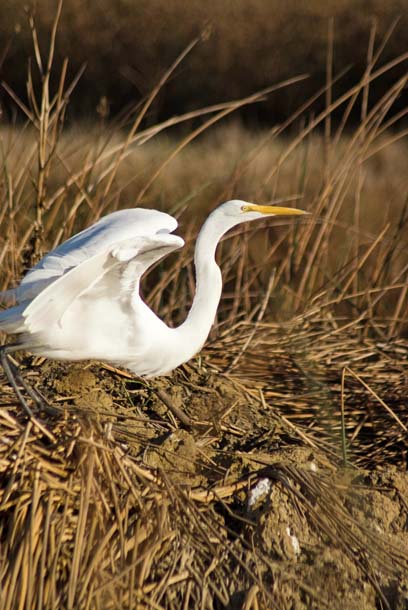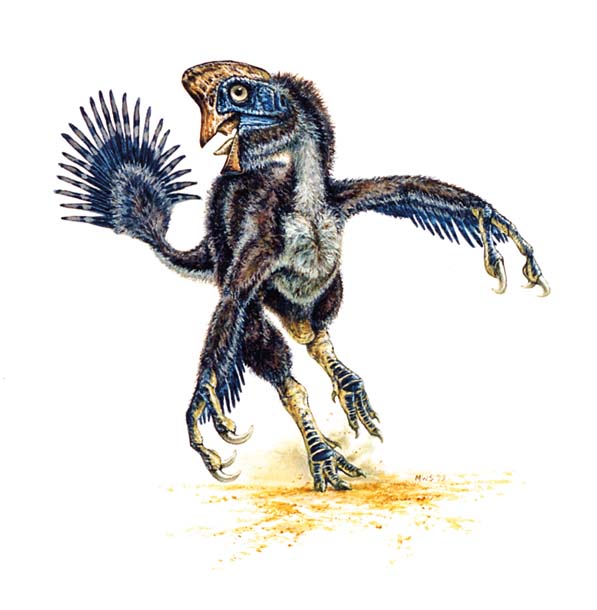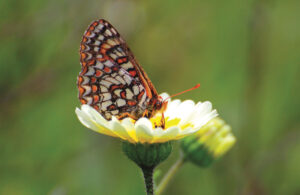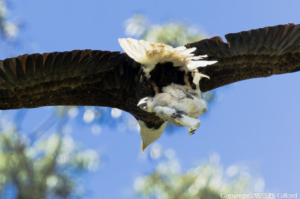“Can we go see the barn owls one more time? Please?” That was my daughter Jade a few Saturdays ago. “OK, OK,” I replied, swept up by her enthusiasm. We found the owls nestled in the rafters of our local barn just as we’d left them an hour before–the buff-colored female wedged up against her snowy-white partner. Only the male cracked open his eyes as we snuck back in for another peek. Their striking, heart-shaped faces appeared almost otherworldly.
Last May, in celebration of International Migratory Bird Day, Jade and I had gone on a guided bird walk at Muir Beach. As we gathered in the parking lot, one of the leaders pointed at his powerful birding scope and said, “Check out the Pacific loons. We’ve seen hundreds cruise by heading north to their Arctic breeding grounds.” It took Jade a minute to get the hang of the eyepiece, but then her eyes widened with amazement as the black-throated fish-eaters zoomed past.
- Artist’s rendering of a feathered dinosaur found in China. Illustration by Michael W. Skrepnick 1999.
“Turkey vultures,” someone yelled. We added ravens, Bonaparte’s gulls, and an Anna’s hummingbird to our list before we set off for the marsh, where we were greeted by a regiment of red-winged blackbirds perched on cattails, scarlet epaulets flashing and metallic voices ringing out. A snowy egret merely flying by was immediately attacked by three dive-bombing blackbirds. Welcome to nesting season. Back on the ground, the kids were captivated by two mallard families, and they laughed with glee as the fluffy yellow chicks waddled to keep pace with their parents. We climbed a nearby hill to see two gangly white red-tailed hawk chicks in a meter-wide nest atop a Monterey cypress. Their parent maintained a steadfast watch nearby.

- It’s easy to imagine this great egret having dinosaur ancestors. Public domain photo: U.S. Fish and Wildlife Service.
The amazing truth of the matter is that every single one of these winged wonders is a dinosaur, members of a family known as theropods that also includes Tyrannosaurus rex. Unbroken lines can be traced from those red-tailed hawk chicks back more than 150 million years to dinosaurs that lived in the Jurassic.
Birds inherited a lot from their ancestors. Hollow bones also lightened the skeletons of their theropod predecessors. Feathers, long thought exclusive to birds, evolved first in ground-dwelling hunters akin to Velociraptor. Dinosaurs likely used those long-ago feathers to show off (think peacocks) and to hold on to body heat (think penguins); only much later were they used for flight. And the parental care of those red-tailed hawks (and most birds) is also an inheritance from dinosaurs.
In a very real sense, those raucous blackbirds are backyard dinosaurs, offering a vibrant window into the distant past. In China, over the past 15 years scientists have unearthed fossils of more than a dozen species of feathered (non-bird) dinosaurs, many of them so similar to birds that it’s difficult to tell one from the other.
So you could say that we still live in the Age of Dinosaurs! With over 10,000 living species, they far outnumber mammals’ measly 6,000 varieties. (To be fair, the past four billion years might be best called the “Age of Bacteria,” but we big creatures tend to overlook anything microscopic.)
We all know kids love dinosaurs. So they must all be out birding, right? No, but they should be. A set of binoculars and a field guide are all you need to get started, and bird feeders offer an excellent way to attract dinosaurs into your own backyard.
Northern California is arguably the best place on the continent for bird-watching; each year, nearly 500 different bird species pass through Point Reyes National Seashore alone, more than are found in each of 40 whole states.
What better carrot to entice youngsters outside than the chance to see living, breathing dinosaurs Watching that robin hunt for worms is not as far removed as you might think from T. rex stalking Triceratops. If your kids aren’t so interested in learning birds’ names, try having them mimic birdcalls and flight movements or make sketches in a nature journal.
Jade and I have decided to become serious dinosaur hunters, so now our hikes have become “treasure hunts” as we look to add more winged neighbors to our respective counts. Just yesterday Jade asked, for the umpteenth time, “Daddy, when can we go back to see the barn owls?”
Get Out!
Join Scott Sampson and Bay Nature for a kid-friendly birding trip to Muir Beach on May 5, 2012 (details at baynature.org/inthefield). Kids and grown-ups can “hunt” for modern dinosaur descendants on bird walks and events throughout our area on International Migratory Bird Day, May 12 this year (birdday.org). San Francisco Nature Education offers kid-friendly bird walks in Golden Gate Park year-round (sfnature.org/programs/calendar.html).

.jpg)




